Changing Ideas About Kingdoms
What are the six kingdoms of life as they are now
identified?
During Linnaeus’s time, the only known differences among
living things were the fundamental characteristics that separated animals
from plants. Animals were organisms that moved from place to place and
used food for energy. Plants were green organisms that generally did not
move and got their energy from the sun.
As biologists learned more about the natural world, they
realized that Linnaeus’s two kingdoms—Animalia and Plantae—did not reflect
the full diversity of life. Classification systems have changed dramatically
since Linnaeus’s time, as shown below. And hypotheses about relationships
among organisms are still changing today as new data are gathered.

Five Kingdoms
As researchers began to study micro organisms, they discovered
that single-celled organisms were significantly different from plants and
animals. At first all microorganisms were placed in their own kingdom,
named Protista. Then yeasts and molds, along with mushrooms, were placed
in their own kingdom, Fungi.
Later still, scientists realized that bacteria lack the
nuclei, mitochondria, and chloroplasts found in other forms of life. All
prokaryotes (bacteria) were placed in yet another new kingdom, Monera.
Single-celled eukaryotic organisms remained in the kingdom Protista. This
process produced five kingdoms: Monera, Protista, Fungi, Plantae,
and Animalia.
Six Kingdoms
By the 1990s, researchers had learned a great deal about
the genetics and biochemistry of bacteria. That knowledge made clear that
the organisms in kingdom Monera were actually two genetically and biochemically
different groups. As a result, the monerans were separated into two kingdoms,
Eubacteria and Archaebacteria,
bringing the total number of kingdoms to six.
-
The six-kingdom system of classification includes the
kingdoms Eubacteria, Archaebacteria, Protista, Fungi, Plantae, and Animalia.
This system of classification is shown in the bottom row
of the table above, the Kingdoms of Life.
Three Domains
Genomic analysis has revealed that the two main prokaryotic
groups are even more different from each other, and from eukaryotes, than
previously thought. So biologists established a new taxonomic category—the
domain.
Domain
A larger, more inclusive category than a kingdom
Under this system, there are three domains—domain Bacteria
(corresponding to the kingdom Eubacteria); domain Archaea (which corresponds
to the kingdom Archaebacteria); and domain Eukarya (kingdoms Fungi, Plantae,
and Animalia, and the “Protista”).
Why do we put quotations around about the old kingdom
Protista? Well, scientists now recognize that this is a paraphyletic group.
This means that there is no way to put all unicellular eukaryotes into
a clade that contains a single common ancestor, all of its descendants,
and only those descendants. Since only monophyletic groups are valid under
evolutionary classification, we use quotations to show that this is not
a true clade. A summary of the three-domain system is shown in the following
table:
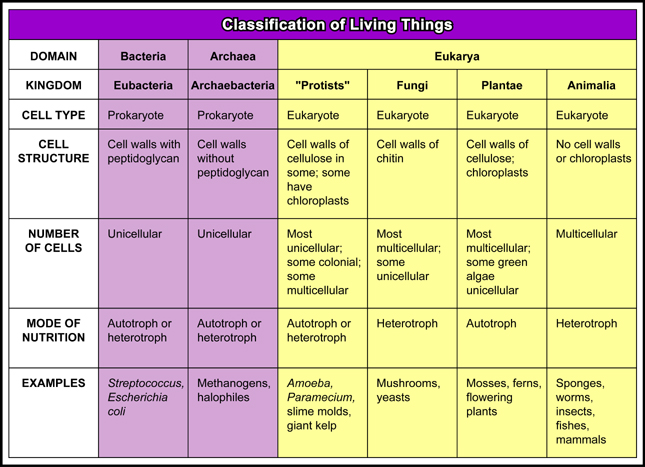
What are the six kingdoms of
life as they are now identified?
REVIEW & DO
NOW
Answer the following questions: |
| How were plants and animals distinguished in Linnaeus'
time?
How were all micro organisms originally classified?
What organisms were placed in the kingdom Monera?
What are the six currently recognized kingdoms of life?
Give an example of one organism in each kingdom. |
|
| What is a domain?
How do prokaryotes compare to eukaryotes? What are
the major differences between them?
What are the three domains of life?
List the kingdoms in each domain.
Are the protista a paraphyletic or monophyletic group?
Explain your answer. |
|
The Tree of All Life
What does the tree of life show?
Remember that modern evolutionary classification is a
rapidly changing science with a difficult goal—to present all life on a
single evolutionary tree. As evolutionary biologists study relationships
among taxa, they regularly change not only the way organisms are grouped,
but also sometimes the names of groups. Remember that cladograms are visual
presentations of hypotheses about relationships, and not hard and fast
facts.
-
The tree of life shows current hypotheses regarding evolutionary
relationships among the taxa within the three domains of life.
| Domain Bacteria
Members of the domain Bacteria are unicellular,
microscopic, and prokaryotic. Their cells have thick, rigid walls that
surround a cell membrane. The cell walls contain a substance known as peptidoglycan.
These bacteria are ecologically diverse, ranging from free- living soil
organisms to deadly parasites. Some photosynthesize, while others do not.
Some need oxygen to survive, while others are killed by oxygen. This domain
corresponds to the kingdom Eubacteria. |
|
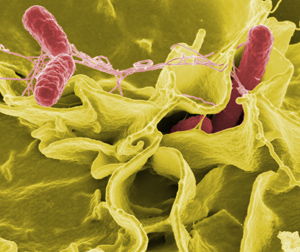
| A scanning electron micrograph
of Salmonella typhimurium invading human epithelial cells. |
|
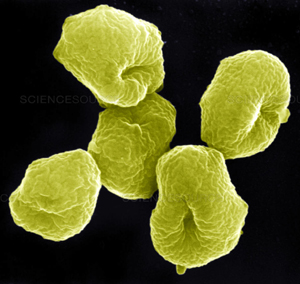 |
| Domain Archaea
Also unicellular, microscopic, and prokaryotic, members
of the domain
Archaea live in some of the most extreme environments
you can imagine—in volcanic hot springs, brine pools, and black organic
mud totally devoid of oxygen. Indeed, many of these bacteria can survive
only in the absence of oxygen. Their cell walls lack peptidoglycan, and
their cell membranes contain unusual lipids that are not found in any other
organism. The domain Archaea corresponds to the kingdom Archaebacteria. |
|
| Sulfolobus.
This member of the domain Archaea is found in hot springs and thrives in
in acidic and sulfur-rich environments. |
Domain Eukarya
The domain Eukarya consists of all organisms that
have a nucleus. It comprises the four remaining major groups of the six-kingdom
system: “Protista,” Fungi, Plantae, and Animalia.
The “Protists”: Unicellular Eukaryotes
| Recall that we are using quotations with this group to
indicate that it is a paraphyletic group. Although some people still use
the name “protists” to refer to these organisms, scientists who
work with them have known for years that they do not form a valid clade.
The Tree of Life, shown below, reflects current cladistic analysis, which
divides these organisms into at least five clades. The positions of these
groups on the cladogram reflect its paraphyletic nature. |
|
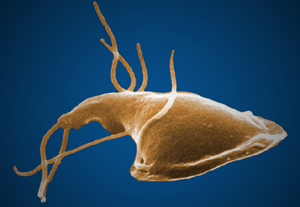 |

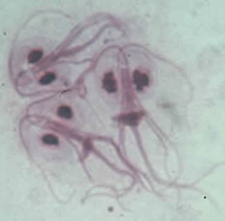 |
| Protists, like the Giardia
(seen above and at left), can live just about anywhere. The Giardia
is a parasitic freshwater ciliate that can infect the human intestine. |
|
| Each group of “the eukaryotes formerly known as protists”
is separate, and each shares closest common ancestors with other groups,
rather than with each other. Most are unicellular, but one group, the brown
algae, is multicellular. Some are photosynthetic, while others are heterotrophic.
Some display characters that most closely resemble those of plants, fungi,
or animals. |
|
Fungi
| Members of the kingdom Fungi are heterotrophs
with cell walls containing chitin. Most feed on dead or decaying organic
matter. Unlike other heterotrophs, fungi secrete digestive enzymes into
their food source. After the digestive enzymes have broken down the food
into smaller molecules, fungi absorb their food into their bodies.
Mushrooms and other recognizable fungi are multicellular. Some fungi—yeasts,
for example—are unicellular. |
|
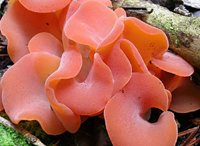 Apricot Jelly Fungus
Apricot Jelly Fungus
|
Plantae
Members of the kingdom Plantae are autotrophs
with cell walls that contain cellulose. Autotrophic plants are able to
carry on photosynthesis using chlorophyll. Plants are nonmotile—they cannot
move from place to place. In this book, we follow the lead of the most
current cladistic analysis, making the entire plant kingdom a sister group
to the red algae, which are “protists.” The plant kingdom, therefore, includes
the green algae, along with mosses, ferns, cone-bearing plants, and flowering
plants.
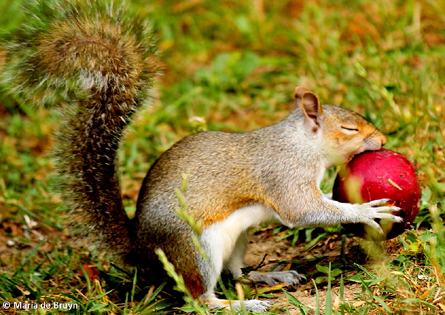 |
Plants and Animals Depend
Upon One Another.
Plants, which are autotrophs,
provide food for animals, which are all heterotrophs, like this brown squirrel,
who will then spread the seeds of the plants it eats. This is a symbiotic
relationship that has developed over millions of years, and upon which
both depend. |
|
Animalia
Members of the kingdom Animalia are multicellular
and heterotrophic. Animal cells do not have cell walls. Most animals can
move about, at least for some part of their life cycle. As you will see
in later chapters, there is incredible diversity within the animal kingdom,
and many species of animals exist in nearly every part of the planet.
What does the tree of life show?
REVIEW & DO
NOW
Answer the following questions: |
Name the two prokaryotic domains and give three characteristics
they both have in common.
How do their cell walls differ?
What makes each domain unique? |
|
What are the three eukaryotic kingdoms?
List three characteristics of each that are unique to
that kingdom.
Name one specific organism from each kingdom. |
|
|


